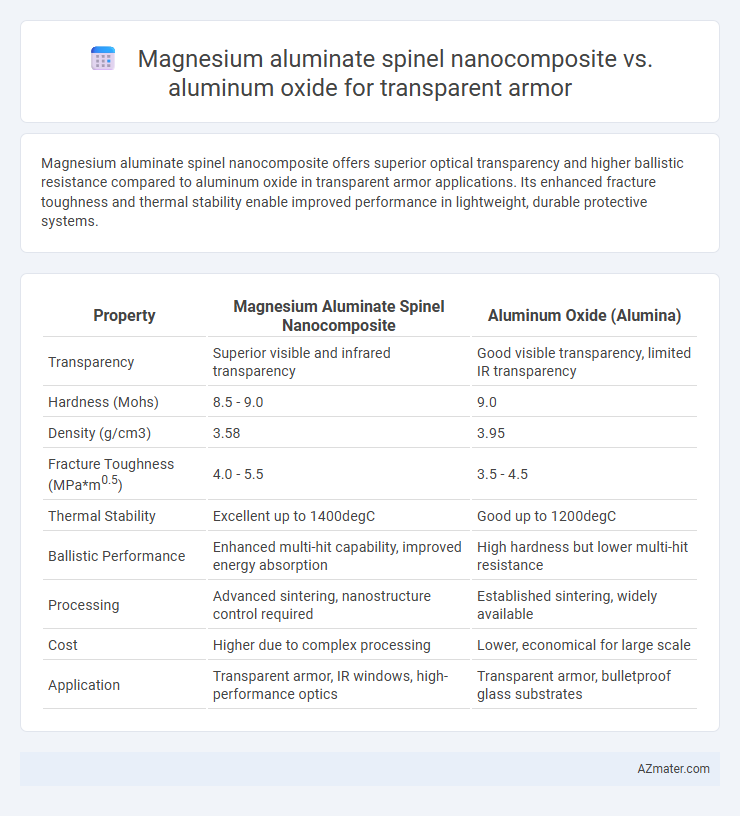Magnesium aluminate spinel nanocomposite offers superior optical transparency and higher ballistic resistance compared to aluminum oxide in transparent armor applications. Its enhanced fracture toughness and thermal stability enable improved performance in lightweight, durable protective systems.
Table of Comparison
| Property | Magnesium Aluminate Spinel Nanocomposite | Aluminum Oxide (Alumina) |
|---|---|---|
| Transparency | Superior visible and infrared transparency | Good visible transparency, limited IR transparency |
| Hardness (Mohs) | 8.5 - 9.0 | 9.0 |
| Density (g/cm3) | 3.58 | 3.95 |
| Fracture Toughness (MPa*m0.5) | 4.0 - 5.5 | 3.5 - 4.5 |
| Thermal Stability | Excellent up to 1400degC | Good up to 1200degC |
| Ballistic Performance | Enhanced multi-hit capability, improved energy absorption | High hardness but lower multi-hit resistance |
| Processing | Advanced sintering, nanostructure control required | Established sintering, widely available |
| Cost | Higher due to complex processing | Lower, economical for large scale |
| Application | Transparent armor, IR windows, high-performance optics | Transparent armor, bulletproof glass substrates |
Introduction to Transparent Armor Materials
Transparent armor materials require exceptional hardness, optical clarity, and impact resistance to protect against ballistic threats while maintaining visibility. Magnesium aluminate spinel nanocomposite offers superior optical transparency across visible and infrared spectra combined with enhanced mechanical strength compared to traditional aluminum oxide. The nanostructured spinel matrix delivers improved fracture toughness and lower density, making it a promising candidate for next-generation protective glazing in military and civilian applications.
Overview of Magnesium Aluminate Spinel Nanocomposites
Magnesium aluminate spinel nanocomposites exhibit superior optical transparency and enhanced mechanical strength compared to traditional aluminum oxide, making them ideal candidates for transparent armor applications. Their unique crystalline structure enables high resistance to ballistic impacts, coupled with excellent thermal stability and corrosion resistance. These advantages position magnesium aluminate spinel nanocomposites as a promising material for advanced protective eyewear and vehicle armor systems.
Properties of Aluminum Oxide in Armor Applications
Aluminum oxide (Al2O3) exhibits exceptional hardness and high fracture toughness, making it a preferred material in transparent armor applications that require enhanced ballistic resistance. Its optical clarity combined with excellent chemical stability ensures durability against environmental degradation while maintaining transparency under high-impact conditions. Compared to magnesium aluminate spinel nanocomposites, aluminum oxide offers a cost-effective balance of optical performance and mechanical strength, supporting lightweight yet robust armor solutions.
Optical Transparency Comparison
Magnesium aluminate spinel nanocomposites exhibit superior optical transparency compared to traditional aluminum oxide, with transmittance levels reaching up to 85% in the visible spectrum, enabling clearer and more effective transparent armor applications. The spinel structure's cubic crystal system results in lower birefringence and reduced scattering losses, enhancing clarity and light transmission under various lighting conditions. In contrast, aluminum oxide (alumina) typically shows lower transparency due to higher refractive index mismatch and grain boundary scattering, making spinel nanocomposites a preferable choice for high-performance transparent armor systems.
Mechanical Strength and Hardness Analysis
Magnesium aluminate spinel nanocomposites exhibit superior mechanical strength and hardness compared to conventional aluminum oxide, making them highly suitable for transparent armor applications. The spinel structure provides enhanced fracture toughness and resistance to crack propagation while maintaining optical clarity, outperforming aluminum oxide's inherent brittleness. These properties result in improved ballistic protection and durability under impact, critical for advanced transparent armor systems.
Ballistic Performance Evaluation
Magnesium aluminate spinel nanocomposite exhibits superior ballistic performance compared to aluminum oxide in transparent armor applications due to its enhanced hardness, fracture toughness, and optical clarity. The nanocomposite's fine-grained structure improves impact resistance and energy absorption, leading to better multi-hit capability and reduced spallation effects under high-velocity ballistic impacts. This combination of mechanical strength and transparency makes magnesium aluminate spinel nanocomposites a more effective choice for advanced transparent armor systems.
Thermal and Chemical Stability
Magnesium aluminate spinel nanocomposite exhibits superior thermal stability compared to aluminum oxide, maintaining structural integrity at temperatures exceeding 1500degC, essential for transparent armor exposed to extreme heat. Chemically, spinel nanocomposites demonstrate enhanced resistance to oxidation and corrosion, outperforming aluminum oxide by preserving clarity and durability in harsh environments. These properties make magnesium aluminate spinel nanocomposites a more reliable and durable choice for transparent armor applications requiring long-term thermal and chemical resilience.
Manufacturing Methods and Scalability
Magnesium aluminate spinel nanocomposites are produced primarily through advanced methods like sol-gel synthesis and spark plasma sintering, enabling uniform nanoscale dispersion and enhanced optical clarity compared to traditional aluminum oxide ceramics fabricated via conventional pressureless sintering or hot pressing. The scalability of magnesium aluminate spinel is challenged by the complexity and cost of nanocomposite manufacturing techniques, whereas aluminum oxide benefits from well-established, high-throughput industrial processes for transparent armor applications. These differences in manufacturing approaches directly influence production costs, transparency performance, and the integration potential in large-scale transparent armor systems.
Cost-Effectiveness and Commercial Viability
Magnesium aluminate spinel nanocomposite offers superior optical transparency and mechanical strength compared to aluminum oxide, making it more suitable for transparent armor applications. The higher production cost of spinel is offset by its enhanced ballistic resistance and weight savings, leading to better cost-effectiveness in long-term deployment. Commercial viability improves as advancements in scalable manufacturing reduce the price gap, driving broader adoption in military and security sectors.
Future Prospects and Research Directions
Magnesium aluminate spinel nanocomposite exhibits superior optical transparency and enhanced ballistic resistance compared to traditional aluminum oxide, positioning it as a promising candidate for next-generation transparent armor applications. Future research directions prioritize improving synthesis methods to achieve uniform nanoparticle dispersion, optimizing microstructural properties to enhance strength and toughness, and integrating multifunctional capabilities such as self-healing and sensor integration. Advanced computational modeling and experimental studies aim to tailor spinel nanocomposites for scalable production and real-world deployment in military and civilian protective gear.

Infographic: Magnesium aluminate spinel nanocomposite vs Aluminum oxide for Transparent armor
 azmater.com
azmater.com